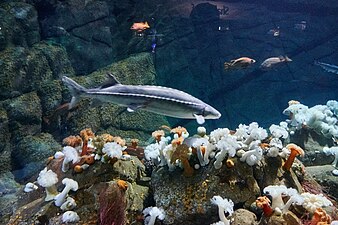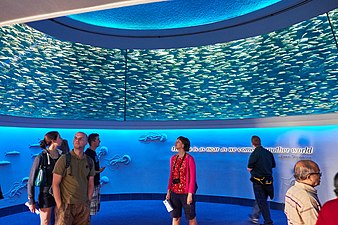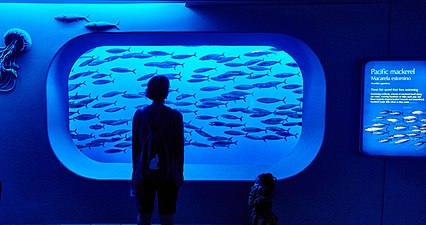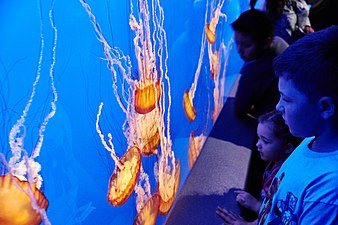Monterey Bay Aquarium
Monterey Bay Aquarium is a nonprofit public aquarium in Monterey, California. Known for its regional focus on the marine habitats of Monterey Bay, it was the first to exhibit a living kelp forest when it opened in October 1984. Its biologists have pioneered the animal husbandry of jellyfish and it was the first to successfully care for and display a great white shark. The organization's research and conservation efforts also focus on sea otters, various birds, and tunas. Seafood Watch, a sustainable seafood advisory list published by the aquarium beginning in 1999, has influenced the discussion surrounding sustainable seafood. The aquarium was home to Rosa, the oldest living sea otter at the time of her death, and it is the birthplace of Otter 841.
Monterey Bay Aquarium
To inspire conservation of the ocean
October 20, 1984
Cannery Row, Monterey, California, U.S.
322,000 square feet (29,900 square meters)[b]
~35,000
550+
1.2 million U.S. gallons (4.5 million liters)
2.3 million U.S. gallons (8.7 million liters)
2 million
Kelp Forest, Sea Otters, Jellies, Open Sea
Early proposals to build a public aquarium in Monterey County were not successful until a group of four marine biologists affiliated with Stanford University revisited the concept in the late 1970s. Monterey Bay Aquarium was built at the site of a defunct sardine cannery and has been recognized for its architectural achievements by the American Institute of Architects. Along with its architecture, the aquarium has won numerous awards for its exhibition of marine life, ocean conservation efforts, and educational programs.
Monterey Bay Aquarium receives around two million visitors each year. It led to the revitalization of Cannery Row, and produces hundreds of millions of dollars for the economy of Monterey County. In addition to being featured in two PBS Nature documentaries, the aquarium has appeared in film and television productions.
Educational efforts[edit]
Each year approximately 75,000 students, teachers, and chaperones from California access Monterey Bay Aquarium for free. An additional 1,500 low-income students, 350 teenagers, and 1,200 teachers participate in structured educational programs throughout the year. Between 1984 and 2014, the aquarium hosted more than 2 million students.[ah] In 2009, the aquarium and others collaborated to create an online resource called "Climate Interpreter", which is used by other zoological institutions, government agencies, and academic institutions to share materials for interpreting climate change to the public.[ax]
A 13,000-square-foot (1,200 m2), US$30 million education center being developed by the aquarium is expected to open in 2018, and will double the number of students and teachers it is able to work with each year.[75][ay] Monterey Bay Aquarium received a Webby Award in 2000 for "distributing information related to scientific exploration"[76] and has won four awards from the Association of Zoos and Aquariums for its programs in the categories of education and diversity.[16] In 2015, the Silicon Valley Business Journal awarded the aquarium with a Community Impact Award for its efforts to "shape a new generation of ocean conservation leaders."[ay]
In media and popular culture[edit]
Monterey Bay Aquarium has been featured in two documentaries on the wildlife television program Nature; filmmakers were given behind-the-scenes access for "Oceans in Glass" in 2006, and "Saving Otter 501" followed the aquarium's sea otter rehabilitation program in 2013.[42] It also heavily supported and was featured in BBC's Big Blue Live, a 2015 live television miniseries about Monterey Bay that won a BAFTA TV Award in 2016.[87] The aquarium served as the filming location for the fictitious Cetacean Institute in the 1986 film Star Trek IV: The Voyage Home.[88] In the 2016 Disney/Pixar animated film Finding Dory, the aquarium inspired the design of the fish hospital that the characters visit, and its animals served as models for the film's animated characters.[89] A scene from the HBO miniseries Big Little Lies, which aired in 2017, was filmed there.[90]
After comparing the aquarium's visitor feedback to the feedback of other attractions, the media and the travel industry have given it top awards. In 2014, TripAdvisor ranked it as the number one public aquarium in the world and, in 2015, it ranked second.[91][92] In 2015, it was listed by Parents magazine as the top public aquarium in the United States and the highest rated destination on the West Coast.[93] Frommer's travel guide lists Monterey Bay Aquarium as "exceptional", the highest rating on its three-tier system.[94]
Each year, since 2019, content creator DougDoug has held a Twitch livestream on the birthday of Monterey Bay Aquarium's oldest sea otter, Rosa. The livestreams have raised a significant amount of money for the aquarium, including $320.18 in 2019, $2,676.00 in 2020, $14,172.00 in 2021, $104,326.89 in 2022, and $302,292.69 in 2023.[95][96][97][98]







